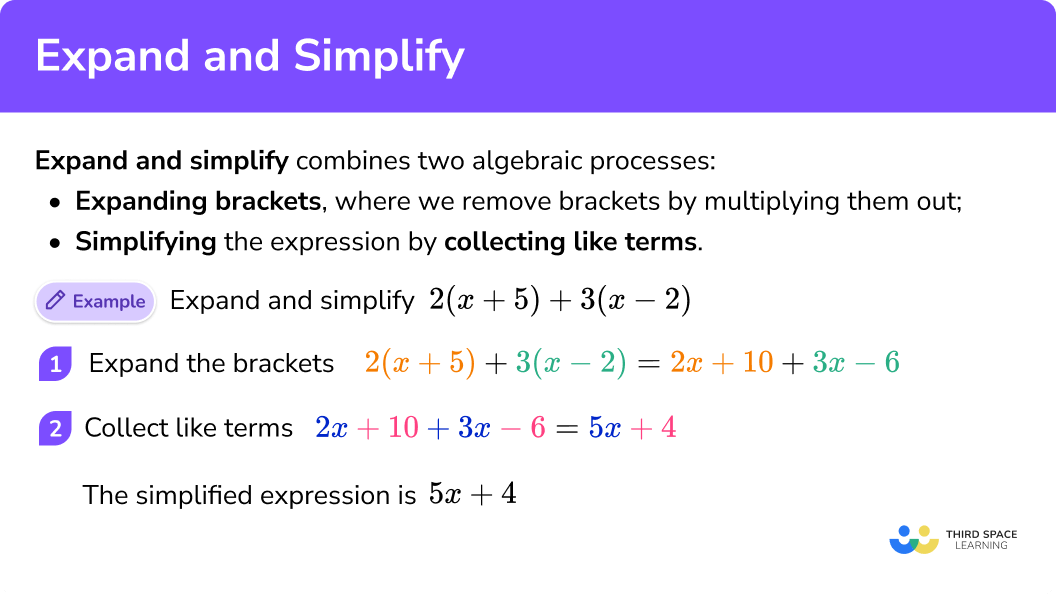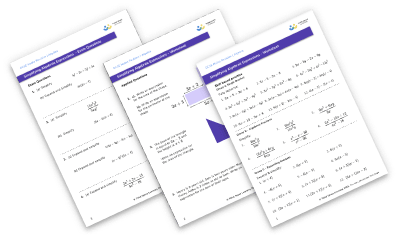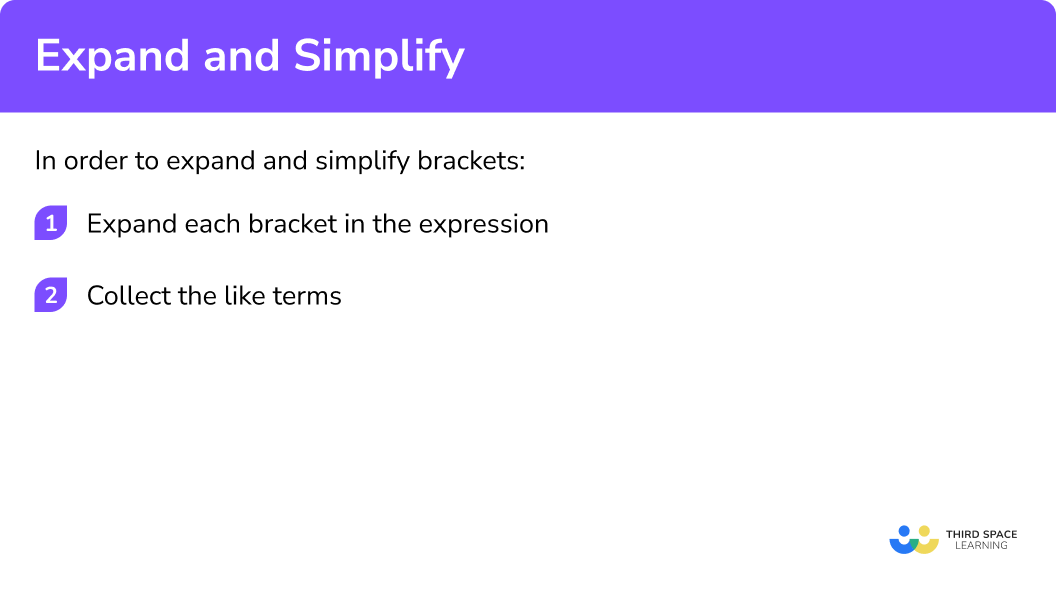GCSE Tutoring Programme
Our chosen students improved 1.19 of a grade on average - 0.45 more than those who didn't have the tutoring.
In order to access this I need to be confident with:
Simplifying expressions Factors and multiples Powers and roots Algebraic expressions Adding and subtracting negative numbers Multiplying and dividing negative numbersThis topic is relevant for:

Expand And Simplify
Here we will learn how to expand and simplify algebraic expressions. First we expand the brackets, then we collect the like terms to simplify the expression.
At the end you’ll find expanding brackets worksheets based on Edexcel, AQA and OCR exam questions, along with further guidance on where to go next if you’re still stuck.
What does ‘expand and simplify’ mean?
In order to expand and simplify an expression, we need to multiply out the brackets and then simplify the resulting expression by collecting the like terms.
Expanding brackets (or multiplying out) is the process by which we remove brackets.
It is the reverse process of factorisation. To expand brackets we multiply everything outside of the bracket, by everything inside of the bracket.
Once we have expanded the brackets we can simplify the expression by collecting the like terms.
E.g.
If we expand and simplify
2(x+5)+3(x-2)we will get
\begin{aligned} 2(x+5)+3(x-2) &=2 x+10+3 x-6 \\\\ &=5 x+4 \end{aligned}What does expand and simplify mean?


Expand and simplify worksheets

Download free expand and simplify worksheets with 20+ reasoning and applied questions, answers and mark scheme.
DOWNLOAD FREE
Expand and simplify worksheets

Download free expand and simplify worksheets with 20+ reasoning and applied questions, answers and mark scheme.
DOWNLOAD FREERelated lessons on algebraic expressions
This lesson is part of our series of lessons to support revision on algebraic expressions. Related step by step guides include:
Multiplying out brackets and simplify
‘Multiplying out brackets’ is another term for expanding brackets. It means exactly the same thing. “Expand the brackets” is the same as “multiply out the brackets”, it just gives the additional clue that when we expand brackets, we are multiplying everything outside the brackets by everything inside the brackets.
How to expand and simplify brackets
In order to expand and simplify brackets:
- Expand each bracket in the expression.
- Collect the like terms.
There are three ways to expand and simplify brackets as covered below:
- single brackets
- two or more brackets
- surds
Explain how to expand and simplify brackets?

- Expand and simplify with single brackets.
Expand the brackets to give the following expression:
E.g. 2(x + 5) + 3(x − 1) = 2x + 10 + 3x − 3) = 5x + 7
Remember: expressions with two terms like
2Expand and simplify with two or more brackets.
Expand the brackets to give the following expression:
E.g. (x + 5)(x − 1) = x2 + 5x − x − 5 = x2 + 4x − 5
Remember: expressions with three terms like
An expression that contains more than two terms and includes variables and coefficients is called a polynomial.
3 Expand and simplify with surds.
E.g. (3 + √5)(2 + √5) = 6 + 3√5 + 2√5 + √5√5 = 11 + 5√5
1) Expand and simplify with single brackets
To expand a single bracket we multiply the term outside of the bracket by everything inside of the bracket. We can simplify the expression by collecting the like terms.
Expand and simplify examples (with single brackets)
Example 1: constants outside of the brackets
Expand and simplify:
2(x + 5) + 3(x − 2)
- Expand each bracket in the expression
Multiply the first bracket:
| ✕ | x | + 5 |
| 2 | 2x | + 10 |
Multiply the second bracket – remember we are multiplying both
| ✕ | x | − 2 |
| + 3 | + 3x | − 6 |
Remember to include the – sign in front of the number.
2(x + 5) + 3(x − 2) = 2x + 10 + 3x − 6
2Collect the like terms
Highlight the two
Remember to highlight the sign in front of the number too!
2x + 10 + 3x − 6
= 5x + 4
Example 2: constants and variables outside of the brackets
Expand and simplify:
2x(x + 6) - 3(x - 2)
Expand each bracket in the expression.
Multiply the first bracket:
| ✕ | x | + 6 |
| 2x | 2x2 | + 12x |
Multiply the second bracket – remember we are multiplying both
| ✕ | x | − 2 |
| − 3 | − 3x | + 6 |
− ✕ − = + so
2x(x + 6) − 3(x − 2) = 2x2 + 12x − 3x + 6
Collect the like terms.
The only ‘like terms’ we have are the two
12x2 + 12x - 3x + 6 12x - 3x = 9x = 12x2 + 9x + 6
Example 3: variables in both terms in the brackets
Expand and simplify:
3(2x − 6y) − 5(x − 2y)
Expand each bracket in the expression.
Multiply the first bracket:
| ✕ | 2x | − 6y |
| 3 | 6x | − 18y |
+ ✕ − = − so
Multiply the second bracket, remember we are multiplying both
| ✕ | x | − 2y |
| − 5 | − 5x | + 10y |
− ✕ − = + so
3(2x − 6y) − 5(x − 2y) = 6x − 18y − 5x + 10y
Collect the like terms.
Highlight the two
Remember to highlight the sign in front of the number too!
6x − 18y − 5x + 10y 6x − 5x = 1x = x − 18y + 10y = − 8y = x − 8y
Practice expand and simplify questions (with single brackets)
1. Expand and Simplify: 3(x+7)-2(x+3)




Expand each bracket
3x+21-2x-6
Collect like terms
x+15
2. Expand and simplify: 8(y-5)-5(y-2)




Expand each bracket
8y-40-5y+10
Collect like terms
3y-30
3. Expand and simplify: 5x(3x-2)-4x(2x+3)




Expand each bracket
15x^{2}-10x-8x^{2}-12x
Collect like terms
7x^{2}-22x
4. Expand and simplify: 5(6x-2y)-2(8x-5y)




Expand each bracket
30x-10y-16x+10y
Collect like terms
14x
2) Expand and simplify with two or more brackets
To expand two or more brackets we multiply every term in the first bracket by every term in each of the other brackets.
Expand and simplify examples (with two or more brackets)
Example 1: variables have a coefficient of 1
Expand and simplify:
(x + 5)(x − 1)
- Expand the brackets in the expression.
| ✕ | x | − 1 |
| x | x2 | − x |
| + 5 | + 5x | − 5 |
x ✕ x = x2 x ✕ − 1 = − x
+ ✕ − = − so the answer is negative.
x ✕ 5 = 5x 5 ✕ − 1 = − 5
+ ✕ − = − so the answer is negative.
(x + 5)(x − 1) = x2 − x + 5x − 5
2Collect the like terms.
The only like terms we have are the two
x2 − x + 5x − 5 = x2 + 4x − 5
Example 2: variables have a coefficient of greater than 1
Expand and simplify:
(2x − 4)(x + 5)
Expand the brackets in the expression.
| ✕ | x | + 5 |
| 2x | 2x2 | + 10x |
| − 4 | − 4x | − 20 |
2x ✕ x = 2x2 2x ✕ 5 = 10x x ✕ − 4 = − 4x
+ ✕ − = − so the answer is negative.
5 ✕ − 4 = − 20
+ ✕ − = − so the answer is negative.
(2x − 4)(x + 5) = 2x2 + 10x − 4x − 20
Collect the like terms.
The only like terms we have are the two
2x2 + 10x − 4x − 20 = 2x2 + 6x − 20
Example 3: with triple brackets
Expand and simplify:
(x + 3)2(x − 1)
Expand and simplify the first two brackets in the expression.
(x + 3)2 = (x + 3)(x + 3)
| ✕ | x | + 3 |
| x | x2 | + 3x |
| + 3 | + 3x | + 9 |
x ✕ x = x2 x ✕ 3 = 3x x ✕ 3 = 3x 3 ✕ 3 = 9 x2 + 3x + 3x + 9 = x2 + 6x + 9
Multiply this new expression with the third bracket and then simplify by collecting like terms.
| ✕ | x2 | + 6x | + 9 |
| x | x3 | + 6x2 | + 9x |
| − 1 | − x2 | − 6x | − 9 |
x ✕ x2 = x3 x ✕ 6x = 6x2 x ✕ 9 = 9x − 1 ✕ x2 = − x2 − 1 ✕ 6x = − 6x − 1 ✕ 9 = − 9 x3 + 6x2 − x2 + 9x − 6x − 9 = x3 + 5x2 + 3x − 9
Practice expand and simplify questions (with two or more brackets)
1. Expand and simplify: (x+3)(x-7)




Expand the brackets
x^{2}-7x+3x-21
and collect like terms
x^{2}-4x-21
2. Expand and simplify: (2x-4)(x-9)




Expand the brackets
2x^{2}-18x-4x+36
and collect like terms
2x^{2}-22x+36
3. Expand and simplify: (x-3)^2(2x+1)




can be written as
(x-3)(x-3)(2x+1)
Expanding the first two brackets gives
(x^{2}-3x-3x+9)(2x+1)
(x^{2}-6x+9)(2x+1)
then expanding again
2x^{3}+x^{2}-12x^{2}-6x+18x+9
and collecting like terms
2x^{3}-11x^{2}+12x+9
4. Expand and simplify: (2x-1)^{3}




can be written as
(2x-1)(2x-1)(2x-1)
Expanding two of the brackets gives
(2x-1)(4x^{2}-2x-2x+1)
(2x-1)(4x^{2}-4x+1)
and expanding again
8x^{3}-8x^{2}+2x-4x^{2}+4x-1
then collect like terms
8x^{3}-12x^{2}+6x-1
3) Expand and simplify with surds
To expand the brackets we need to multiply each term by every other term.
Expand and simplify examples (with surds)
Example 1: with constants and surds
Expand and simplify:
(3 + √5)(2 + √5)
- Expand the brackets in the expression.
| ✕ | 2 | + √5 |
| 3 | 6 | + 3√5 |
| + √5 | + 2√5 | + 5 |
3 ✕ 2 = 6 3 ✕ √5 = 3√5 2 ✕ √5 = 2√5 √5 ✕ √5 = 5 = 6 + 3√5 + 2√5 + 5
2Collect the like terms.
Highlight the two constant terms
6 + 3√5 + 2√5 + 25 = 11 + 5√5
Example 2: with all terms as surds
Expand and simplify:
(√2 + √5)2 − (3 + √5)2
Expand the brackets in the expression.
Expand and simplify:
(√2 + √5)2 = (√2 + √5)(√2 + √5)
| ✕ | √2 | + √5 |
| √2 | 2 | + √10 |
| + √5 | + √10 | + 5 |
2 + √10 + √10 + 5 = 7 + 2√10
Expand and simplify:
(3 + √5)2 = (3 + √5)(3 + √5)
| ✕ | 3 | + √5 |
| 3 | 9 | + 3√5 |
| + √5 | + 3√5 | + 5 |
9 + 3√5 + 3√5 + 5 = 14 + 6√5
Collect the like terms.
Now we will subtract the two answers.
Remember because we are taking away all of
= 7 + 2√10 − (14 + 6√5)
= 7 + 2√10 − 14 − 6√5
= − 7 + 2√10 − 6√5
Practice expand and simplify questions (with surds)
1. Expand and simplify: (2+\sqrt{6})(3+\sqrt{6})\\




(2+\sqrt{6})(3+\sqrt{6})\\
=6+2\sqrt{6}+3\sqrt{6}+6\\
=12+5\sqrt{6}
2. Expand and simplify: (3+\sqrt{5})(2-\sqrt{5})\\




(3+\sqrt{5})(2-\sqrt{5})\\
=6-3\sqrt{5}+2\sqrt{5}-5\\
=1-5\sqrt{5}
3. Expand and simplify: (\sqrt{3}+\sqrt{7})^{2}-(3+\sqrt{7})\\




(\sqrt{3}+\sqrt{7})^{2}-(3+\sqrt{7})\\
=\sqrt{21}+\sqrt{21}+3+7-3-\sqrt{7}\\
=7+2\sqrt{21}-\sqrt{7}
4. Expand and simplify: (\sqrt{2}-\sqrt{8})^{2}-(\sqrt{2}+\sqrt{8})^{2}\\




(\sqrt{2}-\sqrt{8})^{2}-(\sqrt{2}+\sqrt{8})^{2}\\
=2-2\sqrt{16}+8-2-2\sqrt{16}-8\\
=-16
Common misconceptions
- Multiplying all terms in the bracket
We must multiply the value outside the brackets by every term inside the brackets (parentheses).
E.g.
2(6x2 − 3x) = 12x2 − 3x ✖
Here we have not multiplied the value outside of the brackets by the second term.
The correct answer is:
2(6x2 − 3x) = 12x2 − 6x ✔
- Multiplying with negative numbers
For two numbers to multiply to give a + their signs must be the same.
For two numbers to multiply to give a − their signs must be the different.
E.g.
− 4(3y − 5) = − 4y − 20
Here we have not used − ✕ − = +
− 4 ✕ − 5 = + 20
So the correct answer is
- Squaring a term
When we square something, we multiply it by itself.
E.g.
32 = 3 ✕ 3 x2 = x ✕ x (5y)2 = 5y ✕ 5y
When we square a bracket, we multiply it by the entire bracket.
(x + 3)2 = (x + 3)(x + 3) = x2 + 6x + 9 NOT x2 + 9
- Collecting like terms
When we collect like terms we must include the sign in front of the number.
E.g.
3x + 8 + 6x − 2 NOT 3x + 8 + 6x − 2
Expand and simplify GCSE questions
Learning checklist
-
Multiply a single term over a bracket
-
Expand products of 2 or more binomials
-
Simplify and manipulate algebraic expressions by collecting like terms
The next lessons are
Still stuck?
Prepare your KS4 students for maths GCSEs success with Third Space Learning. Weekly online one to one GCSE maths revision lessons delivered by expert maths tutors.

Find out more about our GCSE maths tuition programme.